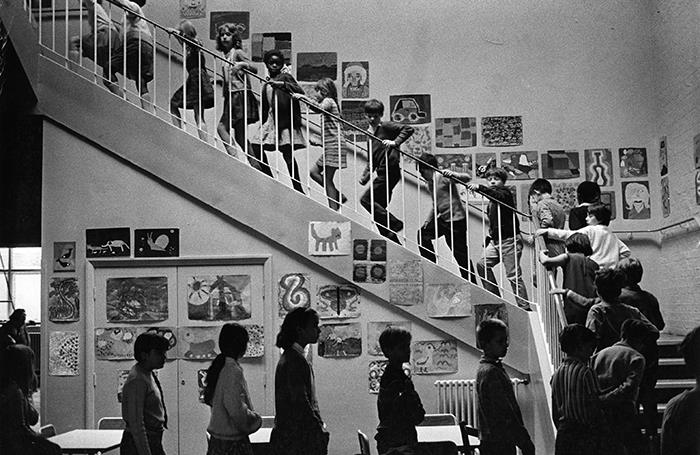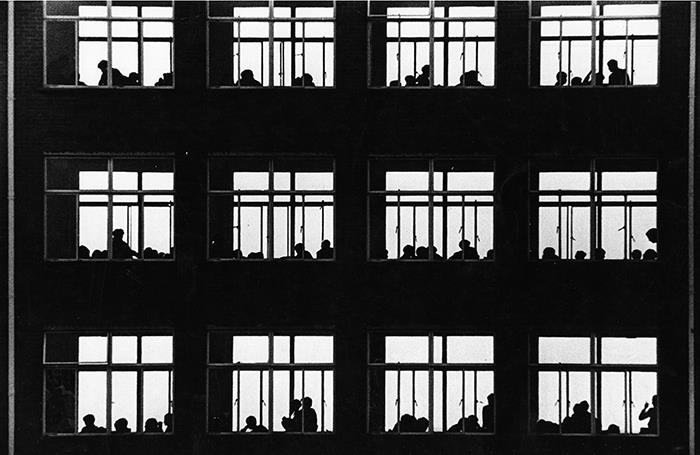About the Manplan series
In 1969, the monthly architecture magazine Architectural Review embarked on an ambitious project: to document the state of the built environment in Britain, to explore its far-reaching impact on society, and to put forward a new vision for architecture.
The result was Manplan, a visual manifesto published in eight special issues between September 1969 and September 1970. The Architectural Review had a history of campaigning for important issues related to the built environment, and the Manplan series was radical in its tone and style, with photography at its centre to critique the impact of architecture on society.

The title ‘Manplan’ referenced the ambition to present a new plan for human beings. Each issue was devoted to an individual area of human activity that was affected by design and planning choices.
The magazine documented the built environment but also proposed an alternative, holistic approach to basic human needs. Guest editors were invited to work with specially commissioned photojournalists and street photographers to develop each theme.
Although photography had been integral to The Architectural Review since the 1930s, the images that defined Manplan were like nothing that had been seen in the magazine before. They focused on people, shifting the emphasis from the architecture itself to the human element within the built environment.
The dramatic black and white images, shot on a 35mm camera in the ‘photo-reportage’ style, created a strong visual statement to support the text of each edition.
The art direction and design of the magazine were graphic and original, providing a powerful backdrop for the striking black and white images. The overall message was strong, uncompromising and a highly critical commentary on contemporary living conditions in Britain. This embodied both the idealism of the 1960s and the disillusionment felt at the end of that decade. Many of the issues addressed are still extremely relevant today.
Eight special issues
Each of the eight issues of Manplan was based around a specific theme:
- Frustration
- Society is its Contacts
- Town Workshop
- The Continuing Community
- Religion
- Health & Welfare
- Local Government
- Housing

How to access Manplan material in the RIBA Collections
Within the RIBA Collections is a significant amount of material relating to the Manplan series, including the magazines themselves and the original photographs commissioned or collected for it (some of which were never published).
You can search for specific material in our collections through our online catalogue. Here are a few pointers.
Manplan issues
Copies of the Manplan issues of the Architectural Review are available to consult through our periodicals collection in the RIBA Library at 66 Portland Place in London. They are open access, meaning you can help yourself to them from the library shelves, where they are bound in volumes by year.
Head to the gallery level of the library and you will find a folder indicating the shelf locations of all our periodicals, including the Manplan series.
Photographs
Photographs from our collection, including those taken or collected for the Manplan series, can be consulted in our library. Key photographers include Patrick Ward, Ian Berry, Tim Street-Porter, Tony Ray-Jones, and Peter Baistow.
We will need to retrieve the photographs for you, so please make an appointment in advance by emailing photo@riba.org.
Some of the photographs have been digitised and are available to browse through our online image library, RIBApix.
Archives
Relevant material in our archive collections includes:
- The Hubert de Cronin Hastings papers - documents, including draft writings and correspondence, belonging to the Architectural Review’s editor during the Manplan era. De Cronin Hastings also used the pseudonym ‘Ivor de Wolfe’.
Further reading (available in the RIBA Library unless marked *)
- Valeria Carullo, Wide Angle View: Architecture as Social Space in the Manplan Series 1969-1970 (London: RIBA Publishing, 2023)
- Hugh Casson, ‘The Elusive Hubert De Cronin Hastings: Royal Gold Medal 1971’ RIBA Journal (February 1971)
- Stephen Parnell, ‘Manplan: The Bravest Moment in Architectural Publishing’, Architectural Review (March 2014)
- Stephen Parnell, ‘Manifesto for the Planet’, Architectural Review (April 2023)
- Catherine Slessor, ‘Humanplan’, Architectural Review vol. 237 no. 1418 (April 2015)






